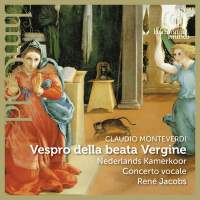Texte paru dans: / Appeared in: |
|
|
Outil de traduction (Très approximatif) |
|
|
|
|
|
Reviewer: J.
F. Weber Remember back when the idea of recording Monteverdi's Vespers began to take on a life of its own? It was 1966. Michel Corboz used period instruments for the first time in this work in April, Denis Stevens used a set of Marian antiphons in June, and Jürgen Jürgens (with Nikolaus Harnoncourt's ensemble and Konrad Ruhìand directing the chant) used both period instruments and Marian antiphons (a different set) along with a few bits of liturgical versicles. Life would never be the same again, though it would get much more complicated in the 1980s. Both of those sets of antiphons matched the modality of Monteverdi's psalms, but they didn't fit any liturgical assignment. Laeva ejus, for example, fits the first psalm on this disc, but it is always used with the second psalm in the Vespers of the Blessed Virgin. I'm going that far back in history—thirty sets of this work have appeared in the meantime— because René Jacobs has duplicated the Jürgens set down to the last versicle. In addition to the six antiphons, he uses a capitulum (a short Scriptural reading chanted on a lesson tone) before the hymn and a versicle with response after it, as well as the final versicle Benedicamus Domino and its response. He even reverses the order of hymn and sonata as Jürgens did, on the mistaken assumption that the sonata served as the suffrage of the saints. (That element of Vespers was not included on feast days, and even then it belongs after the canticle, not before.) In his use of a large adult chorus (twenty-five), he follows a practice not entirely outmoded but certainly sidelined by the more historically aware conductors. As for chiavetti—the little clefs that suggest downward transposition of Lauda Jerusalem and Magnificat, as first employed by Andrew Parrott—Jacobs has considered the point and rejected transposition as unsuitable for concertante singing. (After completing this, I came across a review by a leading musicologist in a prestigious magazine, in which he noticed nothing added to Monteverdi's music except antiphons.) The choir, long admired and now employing Jacobs as one of three rotating directors, offers a big choral sound, quite different from the big men-and-boys choral sound on the adjoining Kreuzchor version. The soloists are not celebrated except for Maria Cristina Kiehr, but they are accomplished. Like Jürgens, Jacobs has even brought in a chant specialist, Wim van Gerven this time, to direct the chant, using a schola drawn from the chorus. I would hardly call the orchestra large—sixteen altogether, the same number as Cantus Cölln's “Vespro-lite“ version (the very “lite“ Scholars on Naxos managed with eleven, and Hermann Max, unheard here, may have used fewer). The notes by Denis Morrier cover some of the relevant issues, and texts come with three translations. The engineering makes everything sound expansive, but we have heard similar sound from historically aware recorded performances. Although the two discs are packaged in the thin jewelbox, it is elegantly slipcased with a large booklet. This adds nothing new to the Vespro choices, but in its own way it is beautifully accomplished. | |
|
|
|
|
|
|
|
Cliquez l'un ou l'autre
bouton pour découvrir bien d'autres critiques de CD |
|




